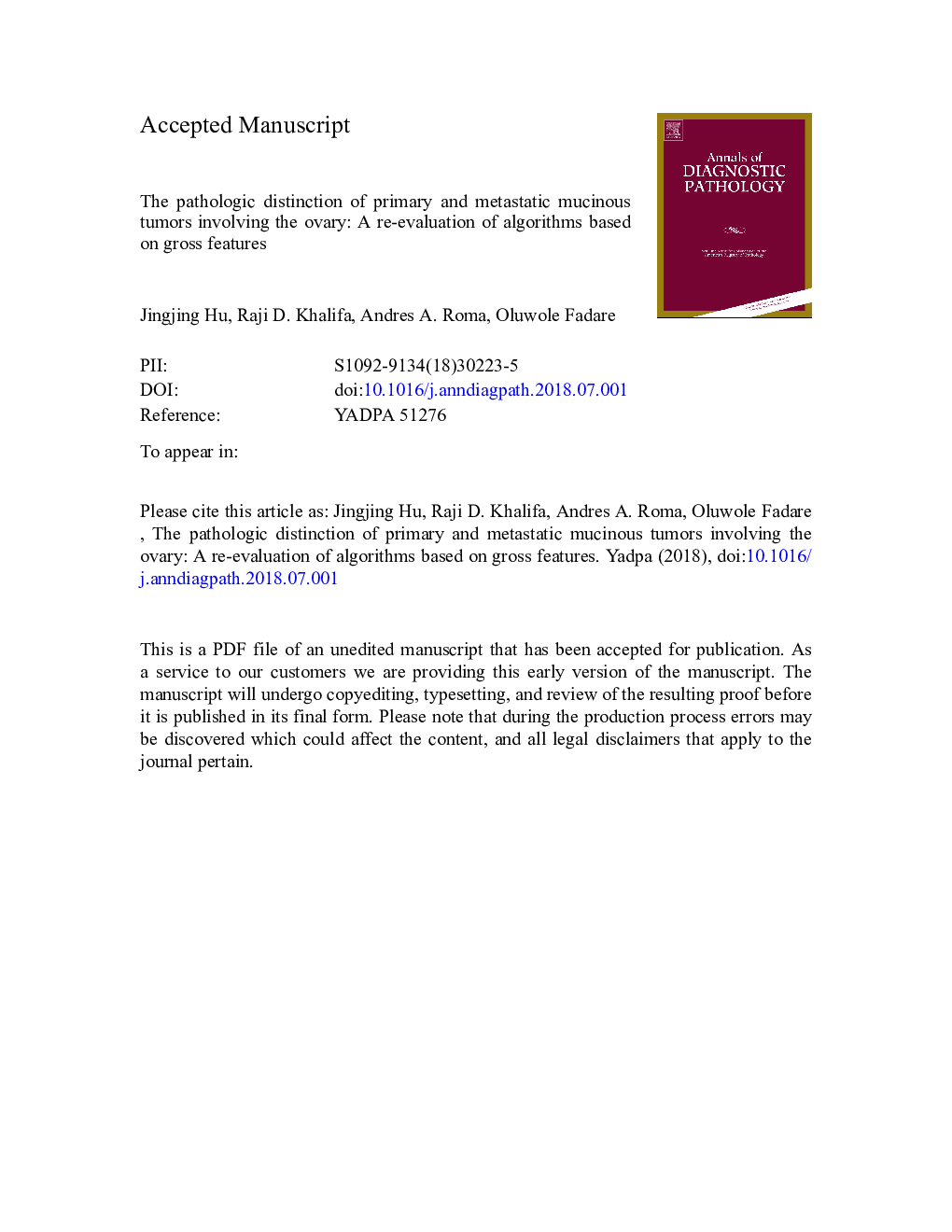| کد مقاله | کد نشریه | سال انتشار | مقاله انگلیسی | نسخه تمام متن |
|---|---|---|---|---|
| 10143995 | 1646277 | 2018 | 22 صفحه PDF | دانلود رایگان |
عنوان انگلیسی مقاله ISI
The pathologic distinction of primary and metastatic mucinous tumors involving the ovary: A re-evaluation of algorithms based on gross features
ترجمه فارسی عنوان
تمایز پاتولوژیک تومورهای مولکولی اولیه و متاستاتیک شامل تخمدان: ارزیابی مجدد الگوریتم های مبتنی بر ویژگی های ناخالص
دانلود مقاله + سفارش ترجمه
دانلود مقاله ISI انگلیسی
رایگان برای ایرانیان
کلمات کلیدی
تخمدان، متاستاتیک، تومورهای مزانشیک، تومور مرزی مزانشیمی،
موضوعات مرتبط
علوم پزشکی و سلامت
پزشکی و دندانپزشکی
آسیبشناسی و فناوری پزشکی
چکیده انگلیسی
The problems associated with the pathologic distinction of primary ovarian mucinous tumors from their metastatic counterparts are well-recognized. Herein, we systematically evaluate a variety of gross parameters to determine the combination of features that most optimally separate primary from secondary mucinous ovarian tumors, and to address the tumor types that are most frequently associated with exceptions. 129 consecutive mucinous tumors involving the ovary formed the study set, including 61 primary mucinous tumors (16 carcinomas, 45 borderline tumors), and 68 metastatic carcinomas (21 colon; 28 appendix; 5 breast; 3 lung; 3 pancreas; 3 cervix; 1 bladder; 4 stomach). Consistent with prior studies, we found that as compared with metastases, primary ovarian mucinous tumors tend to be larger, more frequently unilateral and were more likely to be predominantly cystic and devoid of surface nodules. 41 of the 68 cases in the metastatic group showed intraperitoneal disease, as compared with only 3 of the 61 cases in the primary group (pâ¯<â¯0.0001). In 21% (14/68) of the metastatic group, the ovarian tumor was the first clinical indication of the primary tumor, and 82% of those cases were of gastrointestinal tract primary; this group of cases showed significantly larger tumors than ovarian tumors for patients with an established diagnosis of cancer. Receiver operating curve analyses showed that a tumor size cut off of <13â¯cm for metastatic disease yielded the maximal area under the curve of 0.877 (sensitivity 80%; specificity 80%); the most frequent exception to the size cut off of <13â¯cm for metastases was colorectal carcinoma, 30% of which were â¥13â¯cm. An algorithm whereby a tumor â¥13â¯cm is considered primary unless it displays surface nodules or bilaterality, and a tumor <13â¯cm is considered metastatic unless it is unilateral, correctly classified 94% (64/68) of the metastatic tumors and 98% (60/61) of the primary tumors. 3 of the 4 incorrectly classified cases in the metastatic group had intraperitoneal disease. We conclude that gross features are very useful in the distinction of primary from metastatic mucinous tumors in the ovary, and the presence of intraperitoneal disease provides additional diagnostic information. Although algorithms such as the one described herein are imperfect classifiers, they do provide baseline information on which additional findings, including microscopic features, can be added to ultimately provide the most accurate diagnostic classification.
ناشر
Database: Elsevier - ScienceDirect (ساینس دایرکت)
Journal: Annals of Diagnostic Pathology - Volume 37, December 2018, Pages 1-6
Journal: Annals of Diagnostic Pathology - Volume 37, December 2018, Pages 1-6
نویسندگان
Jingjing Hu, Raji D. Khalifa, Andres A. Roma, Oluwole Fadare,
